SEE THE VIDEO
The Resurrection: Joy, Hope, and Salvation
When Jesus was resurrected, becoming for us The Christ, in that moment, the world was changed forever!
Dark was the time when Judas betrayed Jesus, which led to His suffering, crucifixion, and death on the Cross; a time when the faith of His followers was tested. But when the Messiah, Christ, rose on the third day, their prayers were answered, their faith was fulfilled, and their joy overflowed.
We are living in such dark times, and now it is our faith that is being tested. We feel the sting of betrayal. Through our tears and outrage, we better understand how Jesus suffered, and we are drawn closer to Him.
The feeling is like Death–dark, empty, and cold. But as His disciples came to know, we recognize that Jesus is resurrected; therefore, our faith is fortified, our resolve strong! For we live in the Light and have our being in the Love and Mercy of our Savior Christ Jesus.
Christ is Resurrected! Hallelujah!
My major project for the last five years has been to paint the Stations of the Resurrection (Via Lucis: The Way of Light) when Jesus appeared to His disciples beginning on Easter Sunday over a period of 40 days until he ascended and then gifted them with the Holy Spirit at Pentecost.
I hope that these images will be received in our churches.
The original paintings are in the central nave of the historic Cathedral in Old San Juan, Puerto Rico (Metropolitan Cathedral Basilica of Saint John the Baptist)
Following the images, read more about the recent history of how the Via Lucis came to be sanctioned by the Vatican, as well as on the art and motivations that inspired this all-important project.
Buy high quality giclee prints of these Stations
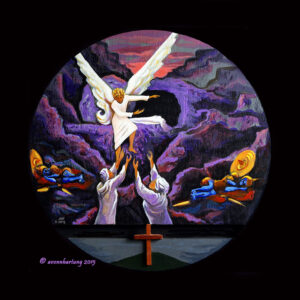
As we approach the first station, we come upon the spectacle of the angel beside the empty tomb who announces that Christ is not there, “He has Risen!” Go tell the apostles He has risen, just as he said. Alleluia, Alleluia Christ has risen! Astonished and euphoric, the women give praise. The bottom half of all the stations shows Christ’s Cross at Golgotha, which for us is the bridge between this life and the life to come, with God in Eternity through Christ’s Resurrection.
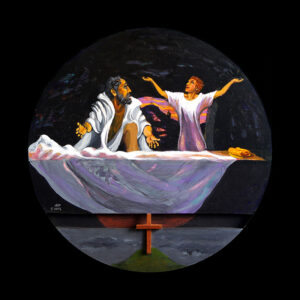
In the second station, we find ourselves inside the empty tomb, witnessing Peter and John’s discovery that indeed Christ has risen from the dead. Their gestures speak to us: Peter’s as if to question “can it be?” John’s gesture says it all— “He has Risen!” The shape of the folds in the burial cloth is a reiteration of John’s expression of uplifting Joy. Here again, we see in the bottom half of the circle, Calvary with the empty Cross, and the abyss that represents death—the Bridge that takes us from suffering and death to eternal life with Our Father, from earthly to eternal reality.
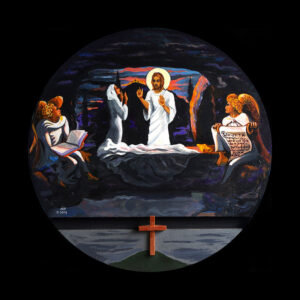
Mary Madelene, frightened and confused, encounters the Risen Lord, and her faith is restored. The Angel to our right holds the scroll of the Old Testament with the verse from Isaiah 1:14 prophesying the coming of Christ who we now see Risen! The angel on our left holds a book, which will be the New Testament, but has yet to be written. In the distance is the hill of Golgotha with the three empty crosses seen in the dawning light of morning. In the bottom half of the circle, Calvary and the abyss that represents death, and the three-dimensional cross, the bridge from earthly to eternal reality.
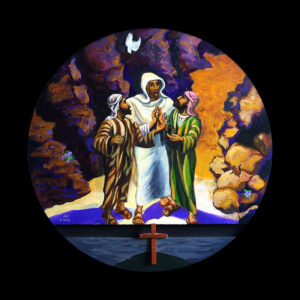
We are on the road to Emmaus with the two disciples who are excitedly telling the apparent stranger of the latest news. There is a great intensity of expression, as evident in the movement of their hands and their closeness; the direction of the road in a dark ravine with repetitive shapes of stones pointing towards them, which indicates the urgency of the news. The dove, symbolizing the Holy Spirit, the lizard, and even the flowers are attentively listening. In the bottom half of the circle, Calvary and the abyss that represents death, and the three-dimensional cross, the bridge from earthly to eternal reality.
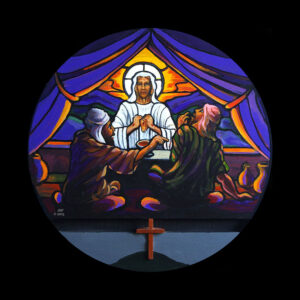
The Risen Lord breaks bread at Emmaus — in the moment of euphoria, as with the women approaching the Angel and the empty tomb on Easter Sunday morning, we witness the two wayward disciples at the moment of awakening when Our Lord offers thanks and breaks the bread. They realize— in that moment, their supper guest is in fact their Lord and Savior, who 3 days earlier they saw die on the cross! The setting is centered, peaceful, and subdued, like the setting Sun, as they share a meal under a tent on the roof of their home in Emmaus. The open curtain reminds us of the veil torn open in the temple when Christ died on the cross. In the bottom half of the circle, Calvary and the abyss that represents death, and the three-dimensional cross, the bridge from earthly to eternal reality.
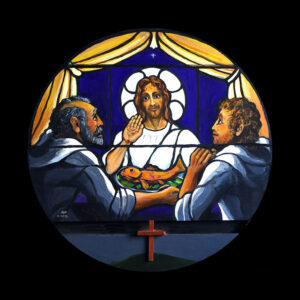
Here we see our Risen Lord appear for the first time to His Apostles. He tells them not to be afraid, that He is not a ghost, in fact, He says He is hungry and asks them for something to eat. Peter offers Him a piece of fish and the Lord gives them His Blessing. In the bottom half of the circle, Calvary and the abyss that represents death, and the three-dimensional cross, the bridge from earthly to eternal reality.
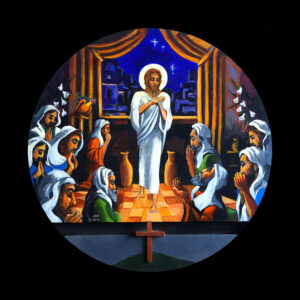
Here we see the disciples, who now know the Risen Lord— they have seen Him before, they have eaten with Him. Christ blows the Holy Spirit on them, giving them the power to forgive sins. The water jugs symbolize their baptism. The rooster crows as a sign of fulfillment. The lilies are a sign of the Resurrection and the purity of the 11 Apostles, having been blessed with the gift of the Holy Spirit and the blessing from Christ. In the bottom half of the circle, Calvary and the abyss that represents death, and the three-dimensional cross, the bridge from earthly to eternal reality.
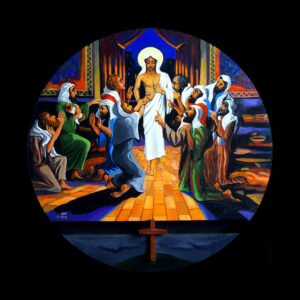
Doubting Thomas—Here we see the timorous Thomas put his finger in the wound. The Lord steadies his trembling hand as the other Apostles look on in curious astonishment and cautious belief. All attention is frozen on Thomas’ finger touching The Lord’s sacred wound— a moment of vicarious certainty — it is true—THE LORD IS RISEN! In the bottom half of the circle, Calvary and the abyss that represents death, and the three-dimensional cross, the bridge from earthly to eternal reality.
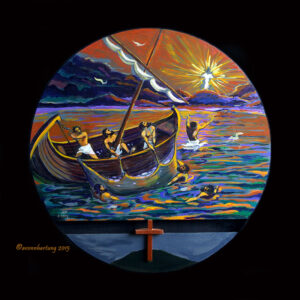
Christ on the Shore— a beacon of light and security. As what often happens, the fishermen come up short without the luck of a catch— the whole night spent without a fish in the basket! Christ appears as a Beacon of Hope. He tells them to cast their nets on “the right side of the boat.” They follow His command, and their nets overflow with fish. He teaches us that blessings flow if we follow His way and have faith in Him, who is our Shepherd. In the bottom half of the circle, Calvary and the abyss that represents death, and the three-dimensional cross, the bridge from earthly to eternal reality.
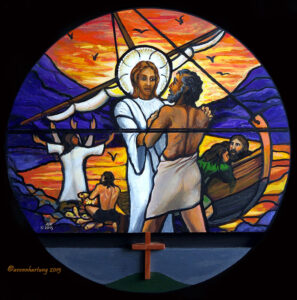
After a breakfast of the fish they caught, Jesus takes Peter aside and asks him, Peter, do you love me? Peter answers three times that he does. Jesús then says, “Peter, if you love me, feed my sheep; if you love me, shelter my sheep; if you love me, protect my sheep, for the commandment I have given you is to ‘love one another as I have loved you.” In the bottom half of the circle, Calvary and the abyss that represents death, and the three-dimensional cross, the bridge from earthly to eternal reality.
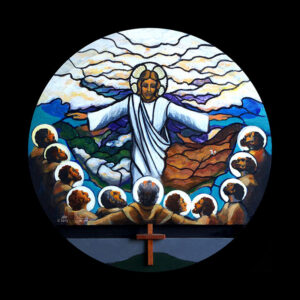
Christ’s great commandment to His Apostles—Go and spread the Good Word to all the nations. This Catholic dimension of His command is expressed symbolically in the half circle of the assembled Apostles. The Circle will be complete when the Word is preached to all the world, expressed symbolically with the dry deserts on one side and the rich rainforests on the other. In the background on the right, we see the diminutive figure of Saul— persecutor of Christ’s followers —on the road to Damascus, where Christ will appear to him and he will become Saint Paul, the great evangelist of the Gentiles! In the bottom half of the circle, Calvary and the abyss that represents death, and the three-dimensional cross, the bridge from earthly to eternal reality.
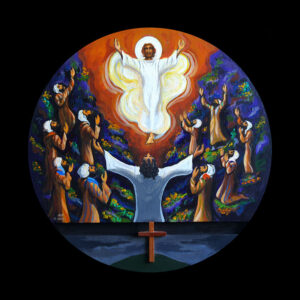
Christ is lifted up before all his Apostles. After Christ tells them that He will send the Holy Spirit to empower and guide them in spreading His Holy Word to all the nations, He is taken up in a Cloud of Glory. The Apostles look on, giving Him thanks and praise. Thanks be to God! In the bottom half of the circle, Calvary and the abyss that represents death, and the three-dimensional cross, the bridge from earthly to eternal reality.
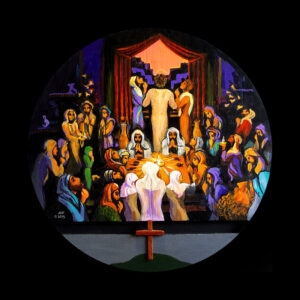
In the upper room before dawn, Christ’s followers are in Vigil, praying and waiting in anticipation for the promised gift of the Holy Spirit. As we do today, in and through our own communities of Faith, we pray for the gift of God’s Holy Spirit in our Holy Catholic Church. I include children as they will be the inheritors of the Catholic faith we pass on to them. In the bottom half of the circle, Calvary and the abyss that represents death, and the three-dimensional cross, the bridge from earthly to eternal reality.
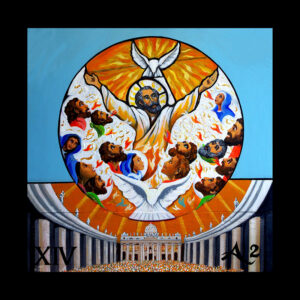
Pentecost Sunday. Here we again see the symbol of Divinity in the Circle. Saint Peter stands amongst the blessed Disciples, enveloped in a cloud of Grace! They receive the Gift of Tongues as flames. This gift of the Holy Spirit, symbolized in tongues, is for the languages of the whole world. Below we see the circle open onto the faithful at Saint Peter’s Basilica in Rome. The pope, standing on the center balcony, raises his arms in unison with Saint Peter, as the faithful gather under and around the 144 Saints that crown the Basilica. The Holy Spirit—God’s gift of Love and spiritual power— rains down on them and continues as a gift to us today, in the name of God our Father, Christ our Savior, and the Holy Spirit now and forever. Amen.
The idea for depicting the Way of Light was inspired by an ancient inscription found on a wall of the San Callisto Catacombs on the Appian Way in Rome. This cemetery is named for Saint Callistus, a slave who eventually became the 16th pope (217-222).
The inscription found at Saint Callistus comes from the first letter St. Paul wrote to the church at Corinth (around 56 A.D.). It was in response to the report that some members were denying the Resurrection. The full statement in the letter is (1 Corinthians 15:3-8):
I delivered to you as of first importance what I had been taught myself, namely that Christ died for our sins in accordance with the scriptures, that he was buried, that he was raised to life on the third day, in accordance with the scriptures, and that he appeared to Cephas, then to the twelve.
Then he appeared to more than five hundred brothers at one time, most of whom are still alive, though some have died. Then he appeared to James, and then to all the apostles. Lastly, he appeared to me, too, as though I had been born when no one expected it.
In 1988 Father Sabino Palumbieri, a Salesian priest and professor of Theological Anthropology at the Salesian University in Rome “proposed the creation of a new set of stations [to complement the Stations of the Cross] centered upon the Resurrection and the events following it, to emphasize the positive hopeful aspect of the Christian story which, though not absent from the Stations of the Cross, is obscured by their emphasis on suffering.”
Father Sabino wrote of this idea in the document “Give Me a Firm Footing” (1999), describing the realizations that he had “after a profound crisis of existential meaning…because of the prospect of death” followed by study of the gospels and recognizing that “With the Risen One, I know why I live.“
“Personally – thanks to this turning point of faith – I was able to proclaim the Risen One continually and in this way propose, as Paul VI said, Christianity as joy, as continual striving to supersede the stalemate of suffering without an outlet.
… A new form of popular piety, by his grace, was sketched out. It is the Via Lucis, which is the physiological second moment of the Via Crucis, that by now has spread itself throughout the five continents.
…So many suffering people write to me saying that every day they do a station of the Via Lucis, drawing from it strength, joy, and peace… It does not mean abolishing the Via Crucis, which is the mirror of the suffering of Calvary without end in the world. It means only completing it with the Via Lucis, which is the mirror of the hopes of the world, especially of those to whom it most rightly belongs, the poor.”
The first major public celebration of the devotion was in 1990. It was officially sanctioned by the Vatican in 2001.
In contemplating painting the Stations, I realized that when Jesus was resurrected, becoming for us The Christ, in that moment, the world was changed forever!
Earth burst into blossom. She glowed with light in the deep night of time. Everything, all Creation was illuminated with Divine significance, light, and hope.
As such, I painted these Stations. The intense color is meant to bring this miraculous change into our consciousness.
The colors are super-infused with hue. Each color becomes the heightened essence of itself. These stained-glass-like paintings might look fantastical. They’re meant to be, however, simple in form and basic in content.
The figures show emotion in their gestures and exaggerated movements. This is to show that reality was turned on its head. Something so unbelievable had occurred that it changed consciousness forever!
The world became full of hope, full of light, and full of meaning because the darkness of death had lost its power, its grip on humanity.
Hallelujah! HE IS RISEN!
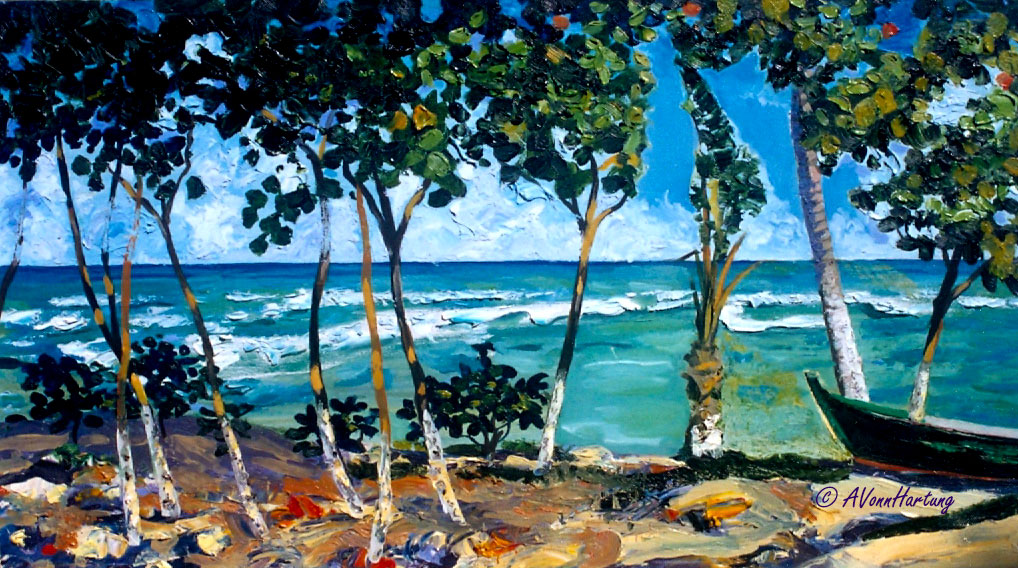
Beautiful work Vonn.
What beautiful inspired art. I hope we end up seeing these stations in all of our churches.
These have come at the right time for the church, especially when people have found no fulfilment in self-indulgence. Many thanks for your great work.
Amazing job! God has given you the wisdom and vision necessary to pass his words thru your art!
Hector. Thank you for your kind and inspiring words!
I know that my ability is a Gift from God; that’s how I heard the Call
to give back that Gift to His church and His People. All blessings, Hector!
Hector, these are beautiful. My church would love to feature your artwork during our online worship service. Please let me know the permissions necessary to do so.
Rebecca, thank you and bless you for your interest! To clarify, my name is Vonn as you can see in my website. (Hector is a friend)
Of course, you have my permission, with attribution, to use my painted Stations of the Resurrection for your virtual online worship service. This is a time to fortify our hope with faith and there is nothing stronger than to pray the Stations of the Resurrection of our Lord and Savior, Christ Jesus. God bless you and your church for your faithful witnessing!
Yours in Christ’s name, AVonnHartung